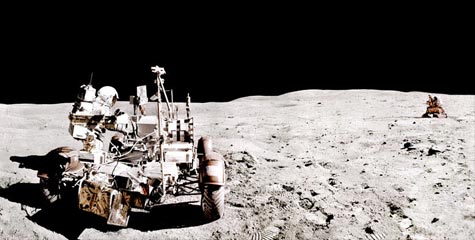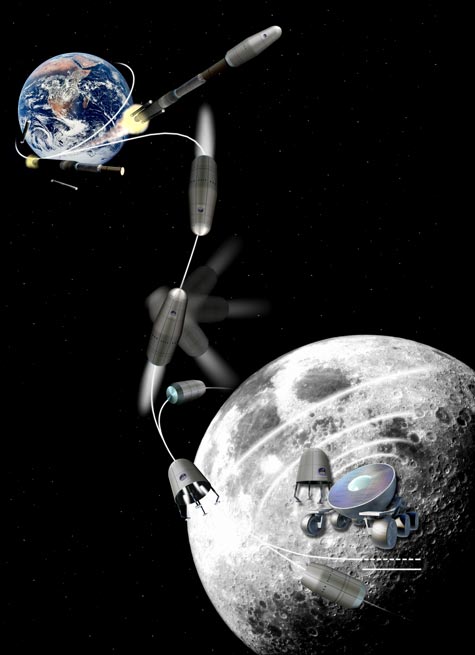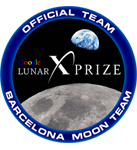High Resolution Images
About
Moon 2.0
The Apollo landings 40 years ago ended the first era of space exploration marked by the confrontation between the U.S. and the USSR in the context of the Cold War. 500 million people worldwide watched the event, the largest television audience for a live broadcast at the time. The confrontation gave way to cooperation and now, sixteen countries have worked together in building the International Space Station (ISS).
With 25,000 million dollars in 1969 (approximately 135,000 million current dollars), the development of the Apollo program was a high investment, which unfortunately was not sustained despite the benefits for humans to explore our moon.
The Moon is an outpost for exploration of the solar system because (1), its gravitational field is one sixth that of the Earth and has enough oxygen to make fuel to launch probes and missions from there, and (2) is a large and stable platform without the impediments of the Earth’s atmosphere, which allows optimum astronomical observation, particularly in its far side where radio waves do not reach.
 On the other hand the Moon is a source of environmental benefits (3) considering the research conducted over 30 years to capture solar energy, clean and abundant, for later use on Earth, through the construction and launch of space collectors from the Moon, which would allow a continuous supply from LEO, even at night
On the other hand the Moon is a source of environmental benefits (3) considering the research conducted over 30 years to capture solar energy, clean and abundant, for later use on Earth, through the construction and launch of space collectors from the Moon, which would allow a continuous supply from LEO, even at night
Moreover, the Moon may help human to survive (4) by serving as a test bench for systems to expand through the solar system as a means of preservation in the event of a major cataclysm on Earth due to the impact of a meteorite, or (5) by collecting a biological library on the Moon, a new Noah’s Ark, to ensure the preservation of life beyond Earth.
Finally, space research develops technologies reverting to society in the form of countless spin-offs like Velcro, the LED lights, solar panels, fireproofing materials, etc. Studies of government agencies like NASA or ESA show that every euro invested in space research is increased to 4 to 6 euros in benefits in other sectors.
Google Lunar X-Prize
 The $30 million Google Lunar X PRIZE is an unprecedented international competition that challenges and inspires engineers and entrepreneurs from around the world to develop low-cost methods of robotic space exploration. The competition’s grand prize is worth $20 million. To provide an extra incentive for teams to work quickly, the grand prize value will change to $15 million whenever a government-funded mission successfully explores the lunar surface, currently projected to occur in 2013.
The $30 million Google Lunar X PRIZE is an unprecedented international competition that challenges and inspires engineers and entrepreneurs from around the world to develop low-cost methods of robotic space exploration. The competition’s grand prize is worth $20 million. To provide an extra incentive for teams to work quickly, the grand prize value will change to $15 million whenever a government-funded mission successfully explores the lunar surface, currently projected to occur in 2013.
To win the Grand Prize, a team must successfully soft land a privately funded spacecraft on the Moon, rove on the lunar surface for a minimum of 500 meters, and transmit a specific set of video, images and data back to the Earth.
Additionally, a second place prize of $5 million will be available for the second team to complete the competition objectives. $4 million in bonus prizes are available for achieving other specific mission objectives, including operation at night; traveling more than 5km over the lunar surface; detection of water; and precision landing near an Apollo site or other lunar sites of interest (such as landing/crash sites of man-made space hardware).
The X PRIZE Foundation is an educational nonprofit prize institute whose mission is to create radical breakthroughs for the benefit of humanity. In 2004, the Foundation captured the world’s attention when the Burt Rutan-led team, backed by Microsoft co-founder Paul Allen, built and flew the world’s first private spaceship to win the $10 million Ansari X PRIZE for suborbital spaceflight.
The Foundation has since launched the $10 million Archon X PRIZE for Genomics, the $30 million Google Lunar X PRIZE and the $10 million Progressive Insurance Automotive X PRIZE. The Foundation, with the support of its partner, BT Global Services, is creating prizes in Space and Ocean Exploration, Life Sciences, Energy and Environment, Education and Global Development. The Foundation is widely recognized as a leader in fostering innovation through competition.
Barcelona Moon Team
The Barcelona Moon Team (BMT) is a multidisciplinary joint venture bringing together entrepreneurial, industrial and academic capabilities representing the only Spanish based team at the GLXP.
Among its objectives are (1) to take the leadership in an ambitious space project. This important project elevates the Spanish aerospace sector to a leadership position in all the aspects related with the management and execution of a highly complex space mission. Thanks to this leadership position the national industry can play a role as a main contractor using its demonstrated experience and capabilities, meaning a competitive advantage. It is foreseen that these capabilities will help win contracts for our companies in the future.
It is foreseen that these capabilities will help win contracts for our companies in the future.
And (2) to foster the scientific and technical vocations and to retain talent; thanks to an extensive communications program with the aim to stimulate the participation of the general public in the event. In one hand scientific and technical careers will be encouraged among the youth, developing specialized knowledge workers for the future. In the other hand the attraction of international talent will bring new professionals and researchers from abroad, stopping the exodus of professionals and young graduates and doctors to other countries.
Galactic Suite Moonrace
Galactic Suite Moonrace is a filial company of Galactic Suite. With its participation in the GLXP, GSMR will gather the know-how to develop future commercial missions both for private or governmental agencies.
The company is developing a network of organizations, companies and research groups from universities, with great individual capacity in very specialized fields and experience in several ESA missions, which will generate new technologies and knowledge for this and future missions.
















